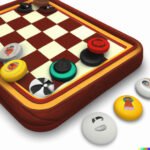Are you a fan of classic checkers board game? If so, you are not alone. With its rich history and enduring popularity, the classic checkers board game has stood the test of time as a beloved pastime for all ages. From its ancient origins to its modern-day variations, this iconic game continues to captivate players around the world.
The history of the classic checkers board game dates back thousands of years, with evidence of similar games found in ancient civilizations such as Egypt and Mesopotamia. Over time, the game evolved and spread to different parts of the world, eventually becoming the well-known and loved classic checkers we play today. Its simplicity and strategic depth have made it a timeless favorite among casual gamers and competitive players alike.
In this article, we will explore the origins of classic checkers and delve into its gameplay, rules, strategies, visual appeal, social connection, variations, and the cognitive and emotional benefits that come with playing this iconic board game. Whether you’re a seasoned player or new to the game, there’s much to discover about this enduring favorite. So grab your board and pieces, because we’re about to embark on an exciting journey through the world of classic checkers.
How to Play Classic Checkers
Setting Up the Game
To start a game of classic checkers, players need a standard 8×8 checkerboard and 12 dark and 12 light-colored checkers. The board should be positioned so that each player has a dark square on their right-hand side.
Game Rules
Players take turns moving their checkers diagonally across the board. They can only move their pieces forward, and they must always keep to the dark squares. If an opponent’s checker is next to one of theirs and there is an empty space behind the opponent’s piece, they can jump over it and capture it. Captured pieces are taken off the board.
Winning the Game
The game is won by either capturing all of your opponent’s pieces or by blocking them so that they are unable to make any more moves. Once this happens, you have successfully won at classic checkers.
Overall, learning how to play the classic checkers board game requires patience, strategy, and observation. The timeless appeal of this traditional board game continues to endure through generations, making it a favorite pastime for people of all ages.
Strategies and Tips for Winning at Classic Checkers
Playing the classic checkers board game requires strategic thinking, careful planning, and a good understanding of the game’s dynamics. One essential tip for winning at classic checkers is to control the center of the board. By occupying the central squares, you gain more options for your moves and limit your opponent’s movements. This simple yet effective strategy can give you an advantage throughout the game.
Another important aspect to consider when playing classic checkers is the concept of piece value. In general, kings are more valuable than regular pieces because they have greater mobility and can move both forward and backward. Therefore, keeping your pieces close together can help in protecting them and increasing their value as they advance toward promotion to kings.
Moreover, being proactive rather than reactive is crucial in classic checkers. Instead of simply responding to your opponent’s moves, make intentional moves that put pressure on them to react. This forces them out of their comfort zone and may lead to opportunities for you to gain an advantage. By incorporating these strategies into your gameplay, you can improve your chances of winning at the classic checkers board game.
| Checkers Strategy | Effectiveness |
|---|---|
| Controlling the center of the board | Highly effective in gaining positional advantage |
| Understanding piece value | Important for protecting and promoting pieces |
| Being proactive in movements | Puts pressure on opponents and creates opportunities |
Visual Appeal
The classic checkers board game is not only a mentally stimulating activity but also holds visual appeal with its iconic black and red checkerboard pattern. The traditional board consists of 64 squares, alternating between dark and light colors, which creates a visually captivating playing surface. This adds to the overall experience of the game, making it not just about strategy and skill but also about the aesthetic pleasure of playing on such a well-designed board.
In addition to the board itself, the classic checkers pieces also add to the visual charm of the game. The contrast between the dark and light-colored pieces further enhances the visual appeal, making it easy for players to distinguish between their own and their opponent’s pieces. These timeless design elements have contributed to the enduring popularity of classic checkers as a visually pleasing board game that people enjoy playing both casually and competitively.
Furthermore, many variations of classic checkers boards are available today, from vintage wooden boards with intricate carvings to modern glass or marble sets. Some boards even come with storage compartments for the pieces, adding a practical yet aesthetically pleasing element to the game. Overall, it is evident that visual appeal plays a significant role in enhancing the overall allure of the classic checkers board game.
| Classic Checkers Board Game Elements | Description |
|---|---|
| Traditional Checkerboard Pattern | 64 squares alternating between dark and light colors. |
| Checker Pieces | Dark and light-colored pieces that add to contrast on the board. |
| Variations of Boards | Vintage wooden boards, modern glass or marble sets, etc. |
The Social Connection
Classic Checkers has long been a traditional pastime enjoyed by people of all ages and backgrounds. Whether it’s played at home with family members, in parks with friends, or in community centers, the game has a unique ability to bring people together and foster social connections.
Community and Bonding
One of the most appealing aspects of the classic checkers board game is its ability to create bonds and strengthen relationships. Playing checkers often involves face-to-face interaction, which can lead to conversations, laughter, and shared experiences. It provides an opportunity for individuals to connect on a personal level, whether it’s through friendly competition or just spending quality time together.
Intergenerational Play
Checkers is a game that transcends generations, making it an ideal pastime for bringing families closer. Grandparents can pass down their love for the game to younger family members, creating valuable opportunities for intergenerational bonding. The game allows players of different ages to engage in meaningful interactions, promoting understanding and respect between generations.
Community Events and Tournaments
In many communities, classic checkers tournaments are organized as social events that attract participants from all walks of life. These events provide a platform for individuals to meet new people, make friends, and engage in healthy competition. Such gatherings not only promote camaraderie but also contribute to building strong community ties.
The classic checkers board game continues to play an important role in bringing people together socially, highlighting its timeless appeal as a cherished traditional pastime. Whether it’s played casually at home or during organized events in communities, the game serves as a conduit for meaningful social connections and shared experiences.
Classic Checkers Variations
When it comes to the classic checkers board game, many people are familiar with the standard 8×8 board and traditional gameplay. However, there are several variations of this beloved game that offer a unique twist on the original version. Whether you’re looking for a new challenge or simply want to change things up, exploring these variations can add a fresh element to your checkers experience.
One popular variation is International Draughts, which is played on a larger 10×10 board with 20 pieces per player. This version introduces a new level of complexity and strategy, as the larger board allows for more movement and tactics. Additionally, there are different rules for capturing pieces and reaching the opponent’s baseline, making International Draughts a favorite among serious checkers enthusiasts.
Another intriguing variation is Turkish Draughts, also known as Dama. This version is played on an 8×8 board like traditional checkers, but with two main differences: men can move both forward and sideways, and kings can move in any direction diagonally. These rule changes create a dynamic gameplay experience that requires players to think strategically about their moves in all directions.
Finally, Giveaway Checkers adds an exciting twist to the classic game by challenging players to be the first to lose all their pieces. Unlike traditional checkers where the goal is to capture your opponent’s pieces, in Giveaway Checkers, players seek to strategically sacrifice their own pieces while preventing their opponent from doing the same.
These variations showcase the adaptability and enduring appeal of classic checkers board game by offering new challenges and opportunities for creativity within a familiar framework. Whether you stick with the traditional version or explore these alternative options, there’s no denying that checkers continues to captivate players of all ages across the globe.
The Benefits of Playing Classic Checkers
Playing the classic checkers board game offers a range of cognitive and emotional benefits that contribute to its enduring popularity. From enhancing critical thinking skills to providing a source of relaxation and social interaction, checkers has proven to be much more than just a simple game.
One of the main cognitive benefits of playing classic checkers is the improvement of problem-solving and strategic thinking skills. Players must constantly assess the board, anticipate their opponent’s moves, and make decisions that will ultimately lead them to victory. This mental exercise can help improve analytical skills, decision-making abilities, and overall cognitive function.
In addition to the cognitive benefits, playing classic checkers can also have positive emotional effects. The game provides an opportunity for relaxation and stress relief as players focus on the task at hand and take a break from everyday pressures. Furthermore, engaging in a friendly game of checkers with friends or family members can strengthen social bonds and create enjoyable memories.
Moreover, the satisfaction of planning and executing successful moves in classic checkers can boost self-esteem and confidence. Winning at the game can provide a sense of accomplishment while losing can offer valuable lessons in sportsmanship and resilience. These emotional benefits contribute to making the classic checkers board game a timeless favorite for people of all ages.
- Improves critical thinking skills
- Enhances problem-solving abilities
- Offers relaxation and stress relief
- Strengthens social connections
- Boosts self-esteem and confidence
The Enduring Popularity of the Classic Checkers Board Game
In conclusion, the classic checkers board game has stood the test of time and continues to be a beloved pastime for people of all ages. Its simple yet challenging gameplay, combined with its rich history and visual appeal, has cemented its place as a timeless favorite in the world of board games. From its origins in ancient civilizations to its enduring presence in modern society, classic checkers has maintained its status as a traditional game that brings people together.
Furthermore, classic checkers offers more than just entertainment; it also provides numerous cognitive and emotional benefits. The strategic thinking required to outmaneuver an opponent, along with the satisfaction of a well-executed move, stimulates the mind and fosters critical thinking skills. Additionally, the social aspect of playing classic checkers promotes bonding and camaraderie among friends and family members.
As we look to the future, it is clear that the classic checkers board game will continue to be a cherished part of our cultural heritage. Whether played on a standard 8×8 board or in one of its many variations, classic checkers remains a symbol of timeless enjoyment and social connection.
Its enduring popularity serves as a reminder of the significance of traditional games in today’s fast-paced world. Whether you’re an experienced player or new to the game, there’s no denying that classic checkers holds a special place in our hearts and will continue to do so for generations to come.
Frequently Asked Questions
How Do You Play Classic Checkers?
Classic checkers is played on an 8×8 game board with 12 pieces per player. Players take turns moving their pieces diagonally forward and jumping over their opponent’s pieces to capture them. The goal is to either capture all of the opponent’s pieces or block them from making any more moves.
What Is the Oldest Game of Checkers?
The oldest game of checkers can be traced back to around 3,000 B.C. in ancient Mesopotamia. This early version of the game was played using round, pebble-like pieces on a game board made of engraved limestone.
Are There Different Checkers Versions?
Yes, there are different versions of checkers played around the world. For example, English draughts is the most common version in the United Kingdom and other English-speaking countries, while international draughts is popular in other parts of Europe and Africa. Each version has its own set of rules and variations that make it unique from the others.

I love playing all kinds of games – from classics like Monopoly to modern favourites like Ticket to Ride.
I created this blog as a way to share my love of board games with others, and provide information on the latest releases and news in the industry.





